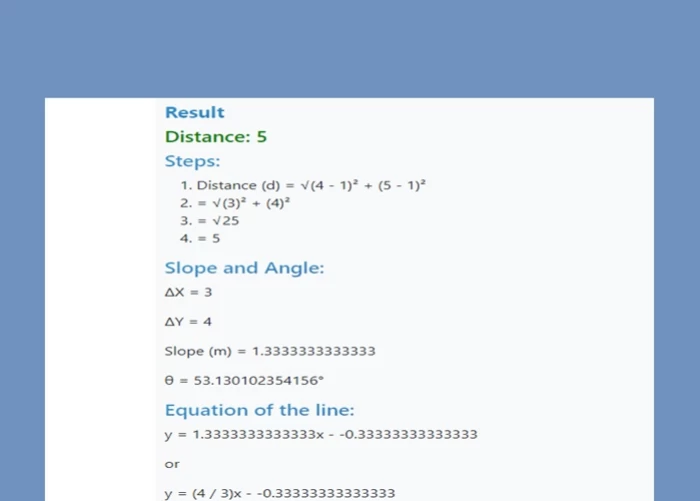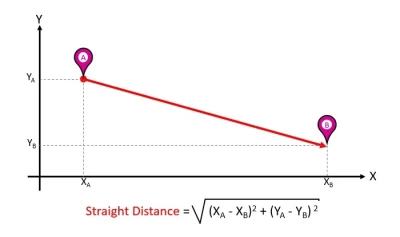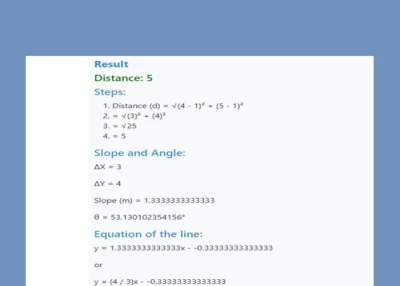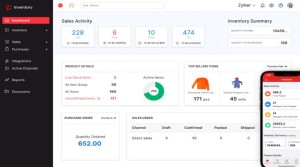Navigating the World with a distance calculator
Say goodbye to uncertainties and welcome a new era of confident navigation as you navigate the world with the precision of a distance calculator at your fingertips.

A distance calculator is like a tool or computer program that figures out how far it is between two places on a map or in the Real World. To do this, it uses different formulas or math rules, depending on what kind of distance you want to know. For example, there's a formula for finding the straight-line distance between two points on a flat surface (like a map) and another formula for figuring out the distance between two places on the round surface of the Earth.
One formula, called the Euclidean Distance Formula, works for flat surfaces and comes in two versions. One is for two-dimensional spaces (like a piece of paper with x and y coordinates), and another is for three-dimensional spaces (like a space with x, y, and z coordinates). Another formula, called the Haversine Formula, is used for figuring out distances on the Earth's surface, which is more like a ball than a flat surface. This formula considers the curvature of the Earth and is often used in geography and navigation.
Just one person didn't discover these formulas; they were developed over time by many intelligent people who studied math and science. The Euclidean formulas have roots in the Pythagorean theorem, and the Haversine formula has a history in navigation. Different formulas are used based on what kind of distance you're interested in and where those points are located.
History of Distance Calculators:
The concept of measuring distance has evolved over centuries, from simple paces and milestones to more sophisticated methods. The first recorded use of a distance calculator dates back to ancient Rome, where the Romans used milestones to measure the distance along their vast network of roads. These milestones marked specific points on the roads and allowed travellers to gauge the distance to their destination.
With the advent of technology, manual methods gave way to mechanical instruments, and eventually, electronic devices emerged. The development of satellite navigation systems like GPS in the late 20th century marked a revolutionary leap in the accuracy and accessibility of distance calculations. Today, distance calculators leverage advanced algorithms and real-time data to provide users with precise measurements and optimal routes.

Benefits of Distance Calculators:
Time Efficiency: Distance calculators significantly contribute to time efficiency by offering users the quickest and most convenient routes. This is particularly valuable for businesses involved in logistics, transportation, and delivery services, where time-sensitive operations are critical.
Cost Savings: Businesses can optimize their resources and reduce operational costs by using distance calculators to plan efficient routes. This is especially crucial in industries that rely on transportation, as fuel consumption and vehicle wear-and-tear can be minimized with strategic route planning.
Enhanced Accuracy: Unlike traditional methods of distance measurement, digital distance calculators provide unparalleled accuracy. This is particularly beneficial in fields such as surveying, construction, and urban planning, where precision is paramount.
Global Accessibility: With the integration of satellite technology and online platforms, distance calculators have become globally accessible. Whether you're planning a road trip across continents or simply commuting within your city, these tools are readily available and easy to use.
Real-time Updates: Many distance calculators utilize real-time traffic data to provide users with up-to-the-minute information on road conditions and potential delays. This feature is invaluable for travellers and businesses alike, ensuring that plans can be adjusted on the fly.
Environmental Impact: By optimizing routes and reducing unnecessary travel, distance calculators contribute to ecological sustainability. Businesses can minimize their carbon footprint by adopting efficient transportation practices, leading to a positive impact on the environment.
Discover a multitude of calculators at CoolCalculator, providing solutions for a wide array of calculations.

A distance calculator is like a tool or computer program that figures out how far it is between two places on a map or in the Real World. To do this, it uses different formulas or math rules, depending on what kind of distance you want to know. For example, there's a formula for finding the straight-line distance between two points on a flat surface (like a map) and another formula for figuring out the distance between two places on the round surface of the Earth.
One formula, called the Euclidean Distance Formula, works for flat surfaces and comes in two versions. One is for two-dimensional spaces (like a piece of paper with x and y coordinates), and another is for three-dimensional spaces (like a space with x, y, and z coordinates). Another formula, called the Haversine Formula, is used for figuring out distances on the Earth's surface, which is more like a ball than a flat surface. This formula considers the curvature of the Earth and is often used in geography and navigation.
Just one person didn't discover these formulas; they were developed over time by many intelligent people who studied math and science. The Euclidean formulas have roots in the Pythagorean theorem, and the Haversine formula has a history in navigation. Different formulas are used based on what kind of distance you're interested in and where those points are located.
History of Distance Calculators:
The concept of measuring distance has evolved over centuries, from simple paces and milestones to more sophisticated methods. The first recorded use of a distance calculator dates back to ancient Rome, where the Romans used milestones to measure the distance along their vast network of roads. These milestones marked specific points on the roads and allowed travellers to gauge the distance to their destination.
With the advent of technology, manual methods gave way to mechanical instruments, and eventually, electronic devices emerged. The development of satellite navigation systems like GPS in the late 20th century marked a revolutionary leap in the accuracy and accessibility of distance calculations. Today, distance calculators leverage advanced algorithms and real-time data to provide users with precise measurements and optimal routes.

Benefits of Distance Calculators:
Time Efficiency: Distance calculators significantly contribute to time efficiency by offering users the quickest and most convenient routes. This is particularly valuable for businesses involved in logistics, transportation, and delivery services, where time-sensitive operations are critical.
Cost Savings: Businesses can optimize their resources and reduce operational costs by using distance calculators to plan efficient routes. This is especially crucial in industries that rely on transportation, as fuel consumption and vehicle wear-and-tear can be minimized with strategic route planning.
Enhanced Accuracy: Unlike traditional methods of distance measurement, digital distance calculators provide unparalleled accuracy. This is particularly beneficial in fields such as surveying, construction, and urban planning, where precision is paramount.
Global Accessibility: With the integration of satellite technology and online platforms, distance calculators have become globally accessible. Whether you're planning a road trip across continents or simply commuting within your city, these tools are readily available and easy to use.
Real-time Updates: Many distance calculators utilize real-time traffic data to provide users with up-to-the-minute information on road conditions and potential delays. This feature is invaluable for travellers and businesses alike, ensuring that plans can be adjusted on the fly.
Environmental Impact: By optimizing routes and reducing unnecessary travel, distance calculators contribute to ecological sustainability. Businesses can minimize their carbon footprint by adopting efficient transportation practices, leading to a positive impact on the environment.
Discover a multitude of calculators at CoolCalculator, providing solutions for a wide array of calculations.
Conversation
Latest Blogs
© Blog CoolCalculator, Explore CoolCalculator, your destination for the latest insights, tips, and updates on the world of online calculators. Stay informed and make your calculations smarter with our blog. ,
Designed
by Saad Media Team , Team Lead M.Rizwan Akhtar












